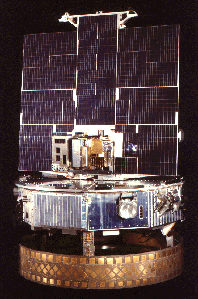|
|
P78-1
Full resolution image

The Space Test Program spacecraft P78-1 was launched on
February 24, 1979 and continued operating until September 13, 1985, when it was
shot down in orbit during an Air Force ASAT test. The platform was of the
Orbiting Solar Observatory (OSO) type, with a solar-oriented sail and a
rotating wheel section.
The instrument payload consisted of a gamma-ray spectrometer, a white light
spectrograph, an extreme ultraviolet spectrometer, a high latitude particle
spectrometer, an aerosol monitor, and an X-ray monitor. The X-ray monitor,
designated NRL-608 or XMON, was a collaboration between the Naval Research
Laboratory and Los Alamos National Laboratory.
The X-ray monitor consisted of 2 collimated argon proportional counters. The
instrument bandwidth of 3-10 keV was defined by the detector window absorption
(the window was 0.01 inch beryllium) and the upper level discriminator. The
active gas volume (P-10 mixture) was 2.54 cm deep, providing good efficiency up
to 10 keV. Counts were recorded in 2 energy channels. Slat collimators defined
a FOV of 3 degrees x 30 degrees (FWHM) for each detector; the long axes of the
FOVs were perpendicular to each other. The long axes were inclined 45 degrees
to the scan direction, allowing localization of transient events to about 1
degree. The centers of the FOVs coincided, and were pointed 40 degrees below
the scan equator of the wheel in order to avoid scanning across the Sun. The
spacecraft wheel rotated once every 6 seconds. This scan rate corresponds to 1
degree every 16 milliseconds; counts were telemetered in 64 or 32 millisecond
bins to minimize smearing the collimator response.
The platform spin vector was perpendicular to the plane of the Sun-
synchronous orbit. Because the detector FOV was not symmetric about the spin
vector, the scan pattern repeated with a 1 year cycle, rather than the 6 month
cycle of the HEAO platforms. Some sources, as Vela X-1, spend as
much as 2 months within the half response bands. Such a long exposure is
particularly useful for studying sources with intrinsic time scales of
days to weeks, such as eclipsing
binaries.
P78-1 was in a noon-midnight, Sun-synchronous orbit at 600 km altitude. The
orbital inclination of 96 degrees implied that a substantial fraction of the
orbit was spent at high latitude, where the particle background prevented
detector operation. In-flight experience showed that good data were obtained
between 35 degrees N and 35 degrees S geomagnetic latitude outside the South
Atlantic Anomaly. This yields an instrument duty cycle of 25-30%. Telemetry
data were obtained for about 40-50% of the orbits, yielding a net data return
of 10-15%. Though this data rate appears low, it means that about 10e8 seconds
of good data reside in the XMON data base.
The instrument parameters and data yield imply a 3 sigma point source
sensitivity of 30 UFU in one day's operation (1 UFU = 2.66e-12 erg/cm2-s-keV). Each detector was about 0.1 of the area of the Uhuru instrument. The
instrument background at low geomagnetic latitudes was ~16 cts/s. Of this
background, ~6 cts/s comes from the diffuse cosmic X-ray background, with the
rest being instrumental. Assuming a conservative 10% data return, the net
source duty cycle in scanning mode is 1.4 X 10-3, implying a source
exposure of 120 seconds per day. For a background of 16 cts/s, the 3 sigma
error in determining the flux from a given sky bin is then 4.5 cts/s, or about
45 UFU, after 1 day. A limiting sensitivity of 30 UFU can be obtained by
combining both detectors. A comparable error will exist in the flux
determination for moderately bright galactic sources. Source confusion due to
the 5 degrees FOV projected along the scan direction will complicate the
observation of sources in the galactic bulge region (approximately 30 deg > l >
-30 deg, |b| < 10 deg).
Data from the P78-1 X-Ray Monitor experiment offer source monitoring with a
sensitivity comparable to that of instruments flown on SAS-3, OSO-8, or
Hakucho, and the advantages of longer observing times and unique temporal
coverage. Five fields of inquiry are particularly well suited for investigation
with P78-1 data. These are
- study of pulsational, eclipse, precession, and intrinsic source
variability on time scales of tens of seconds to months in galactic
X-ray sources.
- pulse timing studies of neutron stars.
- identification and study of new transient sources.
- observations of X-ray and gamma-ray bursts, and other fast
transients.
- simultaneous X-ray coverage of objects observed by other satellites,
such as HEAO-2 and 3, as well as bridging the gap in coverage of
objects in the observational timeline.
[Publications]
[All Missions]
[by Time]
[by Energy]
Page authors: Lorella Angelini Jesse Allen
HEASARC Home |
Observatories |
Archive |
Calibration |
Software |
Tools |
Students/Teachers/Public
Last modified: Thursday, 26-Jun-2003 13:48:16 EDT
|


